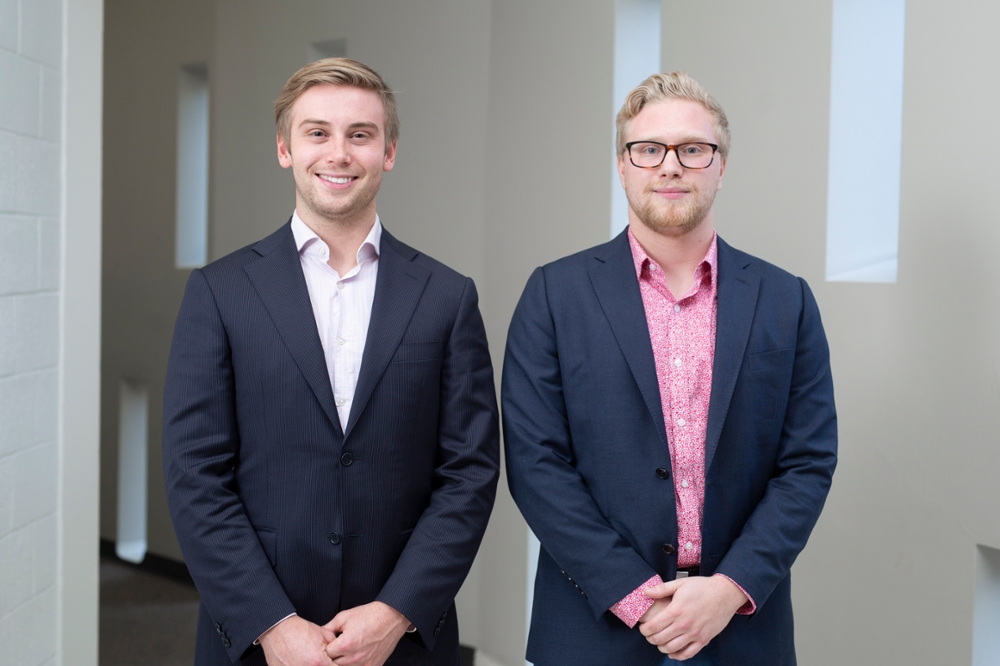
Student teams win dentistry research competition
Student research projects on the effects of sport drinks on oral health, the rate of oral cancer in Saskatchewan, and Syrian refugees’ oral health are the winners of the University of Saskatchewan College of Dentistry’s 2018 Table Clinics competition.
By Federica GiannelliEvery year, Table Clinics showcases research projects undertaken by dentistry students under the supervision of faculty members. The first-place winners will represent the College of Dentistry at the Canadian Dental Association national competition in September 2019.
“Research is the cornerstone of modern evidence-based dentistry. We are very proud of the quality of research produced by College of Dentistry students, and wish Dylan, Donovan, and Duke all the best when representing USask at the national competition,” said Dr. Doug Brothwell (DMD), USask dean of dentistry.
This year’s student winners are:
First place: Effects of sport drinks on oral health
Dylan Jackle, Donovan Shire and Duke Young

The students, supervised by Dr. Mark Berscheid (DMD) and Dr. Phil Chilibeck (PhD), have found that drinking sport drinks during long-distance running may predispose people to develop tooth decay in the long term. Post-doctoral fellow Dr. Whitney Duff (PhD) helped run the study.
The students tested sport drinks on eight long-distance runners during training and found that these beverages increase the acidity of saliva, which in turn erodes tooth enamel — the hard material that covers the surface of teeth and protects them from decay.
The researchers advise athletes to brush their teeth after exercise, or to switch to drinking water after around one hour of exercising — the threshold that the researchers have identified to keep acidity levels in the mouth in check.
Second place: Rate of oral cancer in Saskatchewan compared to Canada and the world
Wyatt Goldade and Ryan Turple

A disfiguring disease, oral cancer is one of the fastest growing cancers in the world, and has a 57-per-cent survival rate. The students, supervised by Dr. Silvana Papagerakis (PhD, MD), found that Saskatchewan’s death rate related to oral cancer has increased in both men and women and that the incidence in Saskatchewan women as young as 25 is around 1.6 per 100,000women, whilethe rest of Canada stands at 0.7 per 100,000.
By 2025, the researchers estimate that there will be almost 2,090 new oral cancer cases in men and more than 1,190 in women across Canada — an increase of more than 20 per cent compared to 2012. Deaths are estimated to increase to almost 290 for males and almost 300 for women, an increase of nearly 30 per cent.
The oral cancer rate caused by HPV has also increased by a significant 30 per cent across Canada, with a peak in people aged 60 to 70 years.
The researchers are still looking into causes of the increase in the mortality rate, but suggest this may be caused by a combination of factors, including smoking and drinking, stress, and vaccination practices for human papillomavirus (HPV). Saskatchewan has been the last province to introduce HPV vaccination in males. Changes in population demographics in the province may also contribute, given people’s diverse backgrounds and genetic predispositions.
The researchers have gathered and compared data from the Canadian Cancer Society and World Health Organization, and they hope their study will help guide prevention strategies for oral cancer in the future.
Third Place: Syrian refugees’ oral health in Saskatoon
Nazli Abtahi, Oleksandr Boyko and Daniel de Jong

The College of Dentistry has been one of the primary providers of dental care for Syrian refugees in Saskatoon since they arrived. The students and their supervisor Dr. Gerry Uswak (DMD) conducted 140 chart audits on the Syrian refugee patients treated over the past three years and found that the oral health of these patients was poor and they faced access-to-care barriers prior to arriving in Saskatoon.
The researchers found that Saskatchewan’s Syrian refugees have a high rate of untreated decayed and missing teeth due to decay, and fewer filled teeth compared to Canadians. Ninety per cent of Syrian refugees seen at the College required dental treatment, and 43 per cent had problems that required urgent dental care.
In six to 11 year-olds, the number of decayed, missing, or filled teeth was three-fold higher compared to Canadians of the same age.
The researchers suggest that in addition to higher dental needs, Syrian refugees face access-to-care barriers as they do not have enough income to pay for dental care. This may contribute to an increase in healthcare costs because Canada’s federally funded insurance program for refugees is time-limited and does not cover all necessary treatments.
Federica Giannelli is a graduate student intern in the University of Saskatchewan research profile and impact unit. This content runs through a partnership with The StarPhoenix.

